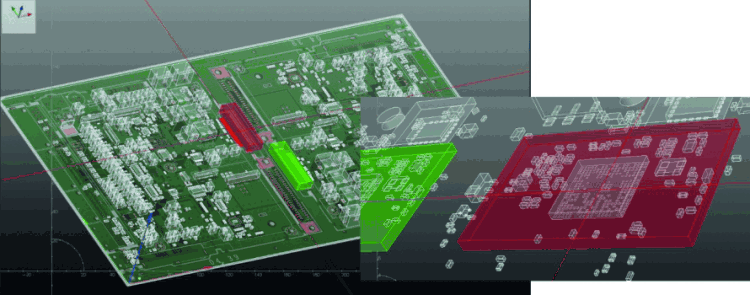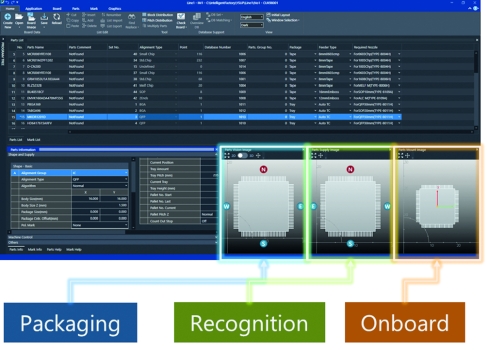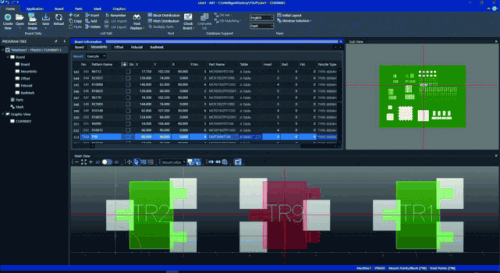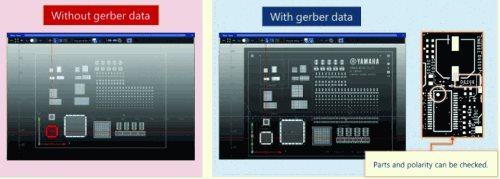
In the pursuit of increased productivity from SMT assembly lines, new technologies have delivered equipment that operates at higher speeds, for longer periods between stops, resulting in increased output at the end of the line. Manufacturing managers also understand the value of optimising machine programs such as placement programs, as well as balancing the demands on individual mounters in each line and throughout a factory, to make best use of the available resources.
Relieving programming pain points
Traditional methods for creating programs have demanded significant human intervention to bring together information from various sources – such as CAD/CAM data, gerber data, the bill-of-materials (BOM) and board images – to create a working program. The programmer’s ingenuity is needed to help programming tools reconcile the differences between the data from various sources, to work with the various different data formats preferred by machine vendors and to overcome obstacles such as missing component libraries.
As software becomes more powerful with each successive generation, more and more of these challenges can become automated to relieve the familiar pain points that have tended to complicate machine programming. As a result, production can start more quickly and the line can begin producing finished boards almost immediately, thereby saving the time spent building test boards, which are traditionally used to help fine-tune the mounter program.
Yamaha has brought together tools to automate programming tasks that are known to be laborious and time consuming, to accelerate program generation and fine-tuning. Consolidating these in a single platform, called YsUP (Yamaha’s Unique and Proven solutions), allows access to all programming related applications.
YsUP leverages the latest approach to machine software and is being introduced with Yamaha’s YRM20 new mounter generation. Material information applications are built in, including monitoring, setup and traceability tools as well setup verification, parts-remaining counting, MSD and LED BIN-code management. Also containing easy-to-use and highly automated programming tools, the result is a unified portal with centralised data management and material handling that allows users to easily switch between applications.
In addition, with 3D viewing of the PCB image and components, users can visualise the assembly almost like a physical model (Figure 1) to see how all parts should be installed and understand component coordinate and angle data clearly.

Data editing and conversion
Using applications within YsUP, production teams can accelerate program creation and enhance production quality by creating needed component data and verifying correct part mounting before committing to building any boards. Real-time drawing allows the user to create component data while constantly comparing with graphical images (Figure 2), which greatly simplifies the task and helps avoid errors.

Working at an earlier stage than traditional virtual sticky tape analysis, desktop trial mounting uses gerber and CAM data to check that parts will be properly positioned relative to their corresponding lands (Figure 3). Detecting errors here allows the necessary corrections to be applied before any boards are produced, resulting in higher production quality and efficiency.

Automatic conversion tools enable users to start producing boards within a short time. Standard CAM data in a format such as ODB++, GenCAD or FABmaster provides essential information such as the mounting coordinates, component information and board image. In this case, the mounting program is easily created with the click of a button using the standard CAM converter. The CAM converter also handles details such as board panellisation and is able to generate a parts layout image. Finally, the program is automatically optimised for the line configuration and parts and nozzles can be checked visually for interference. Templates assist with feeder setup.
Making up for missing data
In the past, programming has often suffered from a lack of the right type of data about the board to be built. This may be as simple as the CAM data and BOM not being available in a suitable format for the CAM converter. The files may express data such as mounting angles or part coordinates in a way that is not supported. YsUP now provides standard tools that can convert text data into a format suitable for generating the program.
Gerber Image Tool
Checking details such as the mounting coordinates, polarity and angle of components in advance can help users ensure their programs produce high-quality boards straight away. With the YsUP Gerber Image Tool, users can quickly generate high-quality PCB images from the board’s gerber data. Where both the board image and gerber data are available, the tool allows an easy comparison to highlight any discrepancies that could lead to parts-placement problems in production (Figure 4).

Moreover, the acquired gerber data can also be used to generate AOI data, allowing users to start generating inspection programs without needing to wait for physical boards to be made available.
Scanner tool
On the other hand, there are cases where the gerber data needed to create the board image is not provided. YsUP helps users create a high-quality board image by scanning the bare board and scaling the image correctly using a glass gauge. The board image can then be combined with the converted mounter program using a visual editor.
In extreme cases, there may be no written data about the original PCB at all. To overcome this, the YsUP scanner tool lets users scan the actual PCB and create all the required data automatically. In other cases, only a paper parts list may be supplied. Here, the YsUP visual editor can help create the program by dragging and dropping parts onto the board image. After the user manually places parts in the correct locations, the tool takes care of aligning each part properly. This is done by leveraging the tool’s auto-teach feature.
Automatic teach and polarity check
Auto teaching compares the board image with appropriate CAD coordinates and parts library definitions to ensure that all components are properly aligned with the associated land patterns, including pin-1 and polarity marks.
Auto teaching automatically corrects up to 1000 parts per minute for any displacement of components, which can result from incorrect or incomplete data. This can happen, for example, if the CAM data describes the centre of the component and its mounting angle data in a way the mounter is not expecting. This can prevent the machine from mounting the parts on the board at the correct position and angle. Auto-teach corrects the errors and shows the wrong-angle data on the error list. A trace function is provided to help verify the corrections without needing to visually inspect all parts on the board.
Parts library wizard
A parts library wizard helps create parts that are not in the standard parts library. The wizard guides the user to provide the parameters needed for component recognition, such as the number of leads, lead size, pitch, component centre position and others. It is also possible to add new parts to the library using a scanned image of the part, taking advantage of the built-in parts-scaling tool to verify the correct measurements.
BOM to skip variation
An additional skip-variation function in YsUP helps users handle multiple different product variants based on the same underlying PCB. This is frequently encountered in the automotive industry, where various differentiated options are offered using the same board for speed and efficiency.
The mount-variation importer tool compares multiple parts lists and generates a variation list that is used to automatically produce a mounter program for each BOM. The program uses a common feeder layout to produce all variants, helping to simplify production activities on the factory floor.
Conclusion
Each successive generation of high-speed SMT placement equipment brings important innovations to raise mounting speeds, increase flexibility, and minimise human intervention. High-performance software tools that combine powerful management and programming applications with automated features and the added convenience of 3D graphics, simplify programming and enhance program quality, making a significant contribution to raising overall productivity.
| Tel: | +27 31 822 8555/6 |
| Email: | [email protected] |
| www: | www.truthelectronics.co.za |
| Articles: | More information and articles about Truth Electronic Manufacturing |

© Technews Publishing (Pty) Ltd | All Rights Reserved